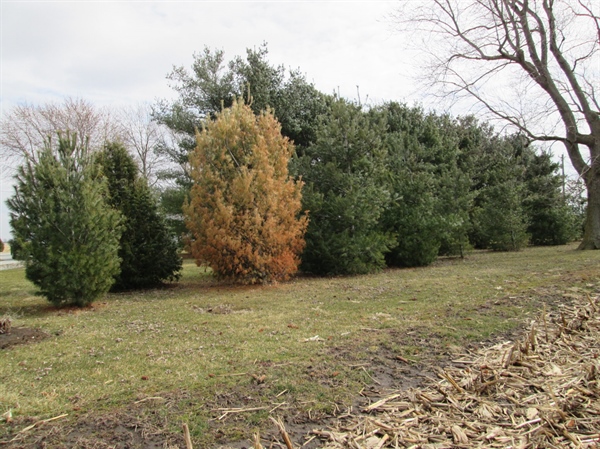It is your favorite time of year. Your insured applied their burndown herbicides in the spring and now a neighbor’s (claimant’s) trees, shrubs, or gardens are looking bad.
Here are some look-alikes that are around that are not related to your insured's burndown application.
- White pine decline – White pines* are looking puny or just plain dying. Early symptoms include pale needles, thinning, and shorter needle regrowth.
- Cone-bearing evergreens susceptible to boring insects – Stressed trees make easier targets for borers. Dead tops curled over and holes or pitch tubes on branches show early issues. Also see other borers mentioned.
- Needlecast – Spruces, specifically Colorado Blue Spruce, are dying from the ground up from a fungus. The first signs include purplish brown color needs and defoliation from the lower branches up.
- Galls on leaves and stems – Galls are weird bumps on leaves and twigs caused by the feeding of living organisms such as bacteria, fungi, mites, and insects.
- Anthracnose – Sycamore anthracnose causes small spots and dead areas along leaves, resulting in premature leaf drop (happening now). This also happens on other trees.
- Dutch elm disease – Elms leaf out and die suddenly around June due to two types of fungi spread by beetles.
- Cicadas (and others) – Cicadas can be found lagging on trees and need to feed on trees constantly for most of their adult lives. Look for slit in branch just under the flagged branch tip.
- Petiole borers in maples – Leaves fall off maples in spring due to the maple petiole borer.
- Hackberry nipple gall – Leaves fall off hackberries due to Hackberry nipple gall-making psyllids (jumping plant lice). Look for bumps (galls) on the underside of the leaf.
- Fire blight – Fire blight is caused by a bacteria that is devastating to apple and pear trees. Scorched looking leaves and shepherd’s crook are two signs of the blight.
Other Issues
- Misapplied brush killers – More is better right? I have had a lot of this the last five years.
- Chemical side pruning – Highway departments, railroads, and utilities are applying herbicides to knock back the roadside trees. Some products have label language “Not for use around evergreens”. You will see twisted tops in white pines and spruces.
- Weed eaters and then a pesticide/herbicide application – I have had claimants weedeat around trees and then use concentrated herbicide straight without mixing in water. Weedeater roughed up the bark making it more susceptible to insect penetration. Concentrate “was easier than mixing.”
- Roadside pesticide/herbicide applications – Some states treat for woody plants to keep grass along roadsides.
- Self-applied pesticide/herbicide for gardens, edging, and driveways, i.e., people use all manner of products to treat weeds around trees and in gardens. They don't read labels and forget to tell you they used them.
- Parking lot applications – What are they applying to control the weeds?
- Golf courses and athletic fields – Growth regulators can affect your claimants' trees.
- Fire damage – Heat from the burn pile can cause damage to the field side of the tree. The claimant said, "I just had a little fire. I burnt some old carpeting".
- Lots of freeze damage in the Nashville, Tennessee, area.
- Hail damage – Can look like borer damage.
Of course, if I can be of service give me a call.
* Note the flat sheets were from Purdue as they have an awesome resource with their Plant and Pest Diagnostic Lab (PPDL).
